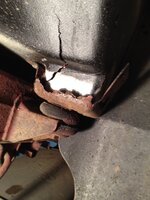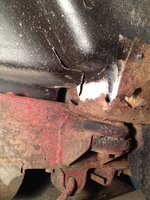Navigation
Install the app
How to install the app on iOS
Follow along with the video below to see how to install our site as a web app on your home screen.
Note: This feature may not be available in some browsers.
More options
You are using an out of date browser. It may not display this or other websites correctly.
You should upgrade or use an alternative browser.
You should upgrade or use an alternative browser.
Proper Fiberglas repair?
- Thread starter deering
- Start date
That's not fibreglass, it's SMC.
SMC is made from a mix of glass, heat activated catalyst and resins. Usually containing epoxy. This is compounded together, then sent to a moulder. The moulder puts this in a high pressure male/female mold and presses it. The heat from this cures the part. Can take as little as a few seconds to large parts taking a minute or two. Repairing this type of part needs to be done with epoxy resins.
You can use SMC repair on fibreglass but not fibreglass repair on SMC. The SMC repair actually works better on fibreglass .
You'll obviously need to order up two new body mount replacements.
SMC is made from a mix of glass, heat activated catalyst and resins. Usually containing epoxy. This is compounded together, then sent to a moulder. The moulder puts this in a high pressure male/female mold and presses it. The heat from this cures the part. Can take as little as a few seconds to large parts taking a minute or two. Repairing this type of part needs to be done with epoxy resins.
You can use SMC repair on fibreglass but not fibreglass repair on SMC. The SMC repair actually works better on fibreglass .
You'll obviously need to order up two new body mount replacements.
- Thread starter
- #3
I now thinking the underbody is SMC so regular Fiberglas resin is a no go. Anyone?
- Thread starter
- #4
Ops looks like you beet me too it Brian.
I don't think you need to over analyse this. On SMC, use SMC or epoxy resin with regular matt. The results will be fine.
The matt has a starch that makes it stiff. Just before you lay it down squish it once LIGHTLY with your hands to make it a little more pliable.
The matt has a starch that makes it stiff. Just before you lay it down squish it once LIGHTLY with your hands to make it a little more pliable.
There is rule when doing glass work/fiberglass repairs. Epoxy bonds to resin but you are never to use regular polyester or vinyIester resins over epoxy. Basically epoxy two part bonds securely to everything.Resins bind to resin obviously. however in boat repair we tend to step up a grade in a lot of repairs. Ie a regular general polyester hull is repaired with vinylester for better strength. It is also a mechanical bond vs a chemical bond as when the it was first constructed.make sure surfaces are roughed and clean. When doing glass work the raw prepped repair is often ground with a 24 or 36 disc to maximize the bond.
Do not buy junk. Composites Canada will offers a large range of products and you might get some good advice if you go in person re how the various fillers etc are created from the epoxy base with granulated additives and powders. http://www.compositescanada.com/
The additives change consistency, bonding characteristics and workability. You can buy fast and slow cure. In this case fast cure is fine as slow cure is often used for large repairs that require a long working time. The more you mix at once the greater the heat given off by the exothermic reaction. So watch your time. The mixing pot can kick off fast if you are not prepared to apply it right away.
I come from a boat repair background and repaired everything from canoes to high performance offshores.
Do not buy junk. Composites Canada will offers a large range of products and you might get some good advice if you go in person re how the various fillers etc are created from the epoxy base with granulated additives and powders. http://www.compositescanada.com/
The additives change consistency, bonding characteristics and workability. You can buy fast and slow cure. In this case fast cure is fine as slow cure is often used for large repairs that require a long working time. The more you mix at once the greater the heat given off by the exothermic reaction. So watch your time. The mixing pot can kick off fast if you are not prepared to apply it right away.
I come from a boat repair background and repaired everything from canoes to high performance offshores.
Last edited:
There is a lot more to the above info. I was just giving you a few key areas to expand on. Note, have the repair area cleaned, all you materials cut, and test fit before you start mixing. Time lost tinkering can add up fast. Sometimes this leaves insufficient working time to finish the repair before things kick off. Which can mess things up a fair amount sometimes depending on the repair. Working upside down can be a pain as the resin migrates and drips, sometimes the repair pulls away also, before it dries fully. For boats we flip them or vacum bag.
Last edited:
- Thread starter
- #8
I picked up some resin that states it's SMC compatible. I have done some boat repairs so I'm a little familiar with the process. I don't have a bunch to do just the rear #4 mount area for now. Frame and under body first then ill do the outer body and paint in a year or 2. Thanks for the help.
Stephen.
Stephen.
Similar threads
Users who are viewing this thread
Total: 1 (members: 0, guests: 1)

